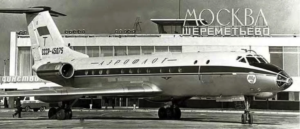by Peter Bridges
Russia is famous for red tape, with paperwork required for just about any activity. I had my own first-hand experiences with this obstructive bureaucracy during my assignment to the USSR 1962-1964.
As assistant general services officer during my first year in Moscow, I ordered forms and furniture, supervised the motor pool, got broken toilets fixed, and tried to keep in operation our creaky Soviet elevators, which liked to break down late on Friday afternoons. While this was not glamorous diplomacy, it probably taught me more about Russia than what I gained as a political officer during my second year in the post.
Bring Out the Body
It was soon after reaching Moscow that I received a telephone call from an embassy colleague in Leningrad. He was escorting a small group of visiting American academics, and one of them had died suddenly of a heart attack. The man was from St. Louis. We cabled the State Department, which quickly got in touch with his family. They asked that we ship the remains to them. We made reservations: Leningrad to Moscow by Aeroflot, and westward from Moscow by KLM.

One of our embassy drivers, Sergei, took me to Sheremetevo airport where I found an Aeroflot employee who confirmed that the coffin had reached Moscow. She had the paperwork in hand. “You owe 1517 rubles,” she said. That was something more than 1600 U.S. dollars.
“Fine,” I said, “Please bill the embassy.”
“We don’t do that. We need cash. How much cash do you have with you?”
“Around twenty rubles.”
“Very well. It is four o’clock. If you want the body shipped on the six p.m. flight, you must pay me the full amount by five o’clock.”
I ran to the car. “Sergei, we’ve got an hour to get to the embassy and back here!”
“We’ll do it!”
It was about 20 miles from airport to embassy, and even back then there was a lot of traffic on our route. But the talented Sergei, speeding down Leningradskoye Shosse with horn blasting and headlights shining, got us to the embassy in good time. Whatever the cops thought our Ford was up to, they didn’t stop us.
I ran into the embassy and found Dorothy Weihrauch, the budget and fiscal officer. “Dorothy, I need 1600 rubles. I’ll explain later.”
With scarcely a word she gave me the money. I got back to the Aeroflot lady before the hour was up. “Very well,” she said, “And now you must see Customs.”
Customs was in a large shed which contained, most notably, a large coffin and a thin customs officer. He looked like a character from Gogol: visored cap, uniform with many buttons, and rimless old-fashioned eyeglasses.
I handed him the Aeroflot waybill and a long document from Leningrad with statements by the police and municipal authorities, testifying to the death and the preparations for shipment. “All is in order,” I said.
“No, it is not,” he said after slowly reading all the paperwork. “The statement that is said to be from the City Soviet lacks the necessary round stamp. The shipment cannot be made.”
“Inspector,” I said, “This poor man’s family is waiting, thousands of kilometers from here…”
And then I had a thought. What if I offered him my twenty rubles? Would he take a bribe, or would I be expelled from the Land of the Soviets—which might not be so bad an outcome? But instead I said, ”Inspector, just this once could you make an exception?”
Marvelous to say, he made an exception. I never asked him for another one.
Diplomatic Note for Frozen Meat
In our second Moscow year I became a political officer and my wife, Mary Jane, who had studied at Columbia’s Graduate School of Business, became the manager of our embassy commissary. It was a sizable enterprise. She imported canned goods by rail freight from the U.S. Army Commissary in West Berlin, fresh produce and dairy products by overnight train from Helsinki, and frozen meat by air from Copenhagen. She dealt constantly, of course, with Soviet Customs.
One day Customs would not release a meat shipment to us. The required Danish customs certificate was missing. Mary Jane went running to Jim Moran, our administrative officer, and they produced a noble document, on a sheet of the long paper used for formal diplomatic notes: “The Embassy of the United States of America presents its compliments to the Customs Administration of the Union of Soviet Socialist Republics and has the honor to state that the shipment of 52 kilograms of frozen meat for this Embassy which has arrived on today’s date on SAS flight 42, air bill 56662, from the firm Peter Justesen Company A/S in Copenhagen, Kingdom of Denmark, was not accompanied by a Danish customs certificate.”
To this imposing note Jim Moran added a length of red tape – fighting red tape with red tape — and pressed on it the raised embassy seal. “Now,” he said, “Let’s see if this will work.” It did; we got the 52 kilos without further argument.
Hot Line Hold Up
There were even problems with the arrival of equipment for the new “hot line,” a direct communications link between Moscow and Washington known in popular culture as the “red telephone.” In May 1963 Glenn Seaborg, chairman of the then-U.S. Atomic Energy Commission, flew to Moscow on Air Force One, which President John F. Kennedy had lent him for the visit. U.S.-USSR relations were looking up; Seaborg came to sign a bilateral agreement on peaceful uses of atomic energy. The plane also brought the U.S. equipment to be used on the Soviet end of the hot line link, aimed at enabling quick communication between the Pentagon and Kremlin at tense moments like the Cuban missile crisis some months earlier. (The 1963 equipment was teletype; today’s hot line is a secure computer link.)

Dr. Seaborg was greeted on arrival by his Soviet counterpart, Andronik Petrosyants, and our ambassador, Foy Kohler. I was below, standing under the belly of the Boeing 707, to watch the hot line equipment crates being unloaded and placed on dollies to go to the Customs shed. This time, I thought as I walked along with the dollies that the airport authorities had provided, there’ll be no problems with Customs.
“What’s all this?” asked a Customs official, looking at all the big crates.
I explained.
”We know nothing of this,” he said. Could it be? Yes. For the next half-hour I tried without success to locate a Soviet official who could explain matters to Customs. Finally, I managed to reach our embassy’s air attaché, Colonel William F. Scott, who laughed and said “Incredible! But I’ll get hold of the Defense Ministry.”
Soon the emergency direct communication link went into operation, with, I hoped, more efficiency than I’d seen at the airport.
Red Stamping the Mail
If the USSR didn’t work well in many ways, it was in general an efficient police state. Take the mail, for example. Any envelope with a letter to or from a foreign embassy was given not just a normal postmark but one in red, marked, in Russian, International Post Office. That mark sent it to the KGB to be skillfully opened, read, and resealed.
One day we began to get letters from Russians that lacked the red postmark. Not many of them; a few score, not hundreds. Contacts with a foreign embassy, actual or alleged, could bring imprisonment. Most of the writers sounded desperate. One woman wrote from Odessa that she was in her seventies, had tuberculosis, and lived in a small and damp basement room she shared with two others. Could we help?
We did not respond to the letters. We could not help and we did not want to worsen the senders’ plight. Whatever the glitch had been in the censor system, soon the red postmark began to reappear on envelopes. But the letters that had come in that short interval were something I did not forget.
There was not a lot to laugh about in the USSR, but my colleagues and I had a chuckle over one letter that arrived sometime after the red postmarks resumed. The letter had been duly stamped with the postmark—not on the envelope but on the first page of the letter. The poor fellow who made the censorship system so patently obvious would have had a red face if found out—and would perhaps have been sent to Siberia. We did not laugh long.![]()

Peter Bridges spent three decades as a Foreign Service officer on four continents, ending as ambassador to Somalia. In recent years he has published a memoir of his time as a diplomat; biographies of two once-famous Americans, John Moncure Daniel and Donn Piatt; and a memoir of his off-hours climbs, runs, and treks. His articles, essays, and poems have appeared in American Diplomacy, Copperfield Review, Diplomacy & Statecraft, Eclectica, Mountain Gazette, Virginia Quarterly Review, and elsewhere.
